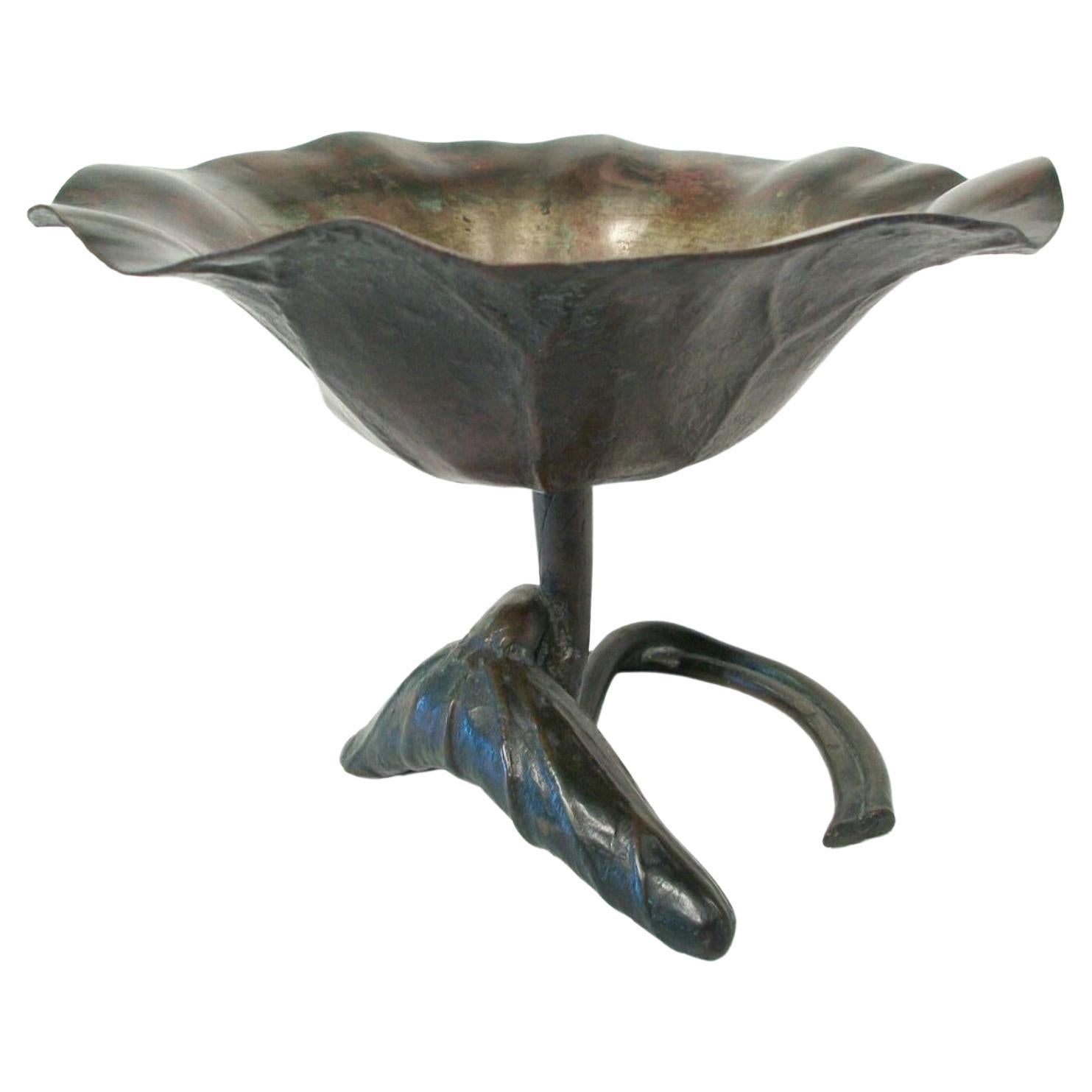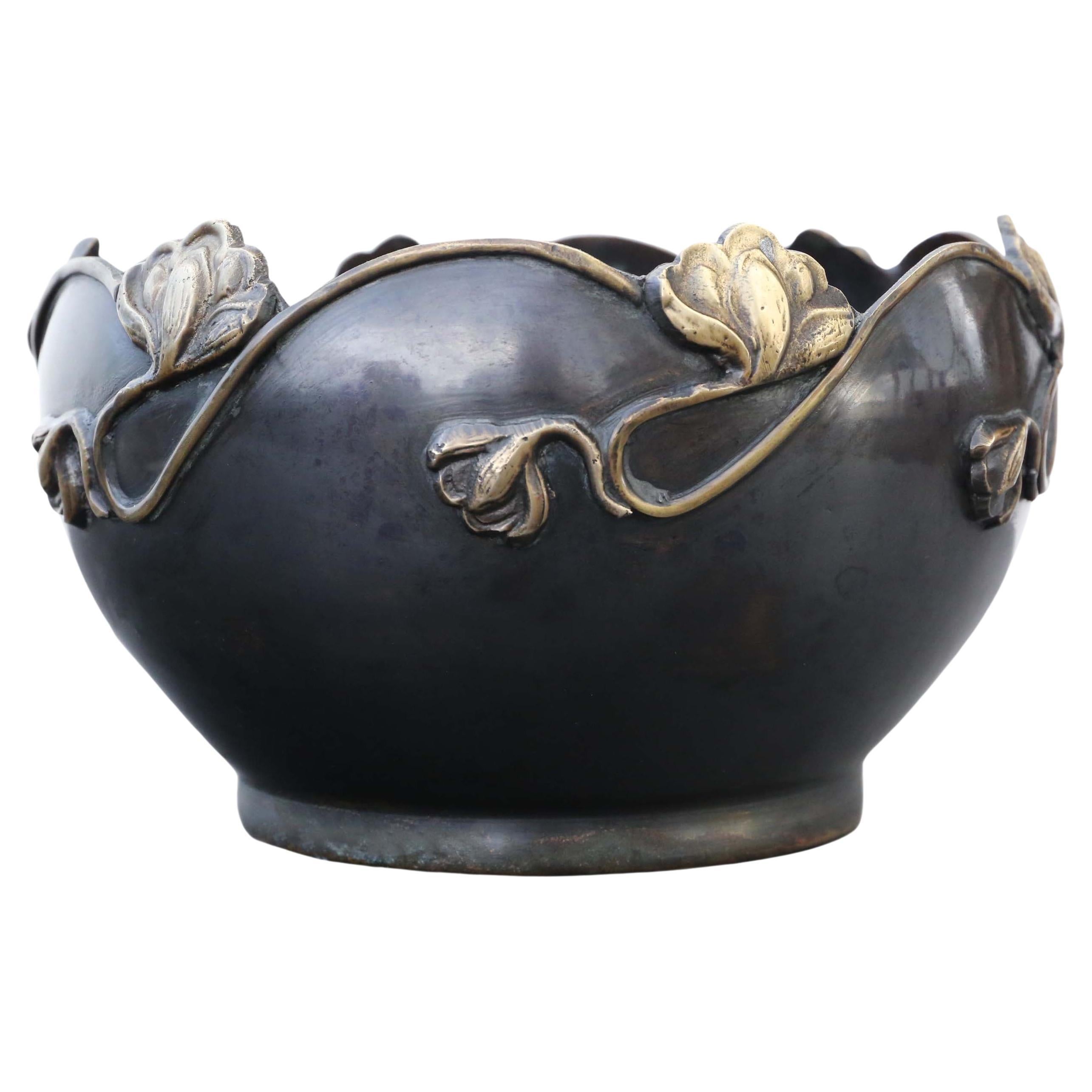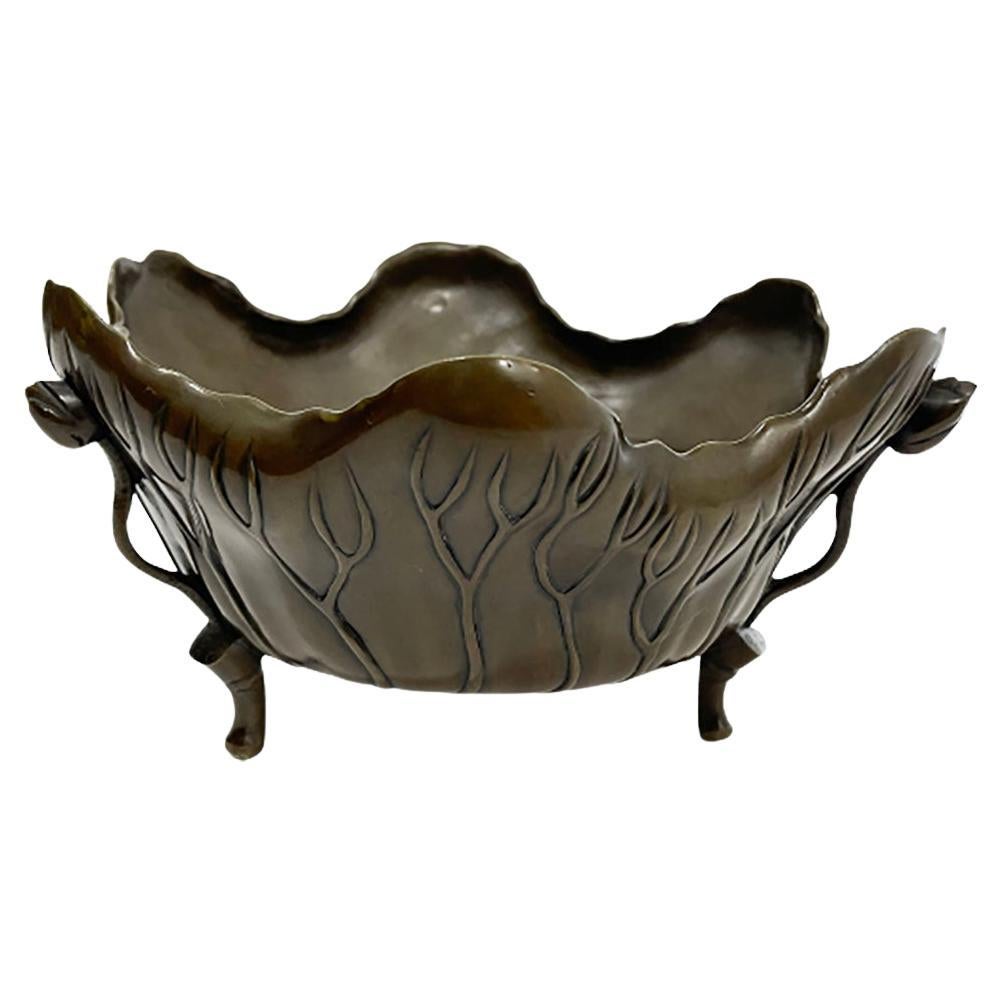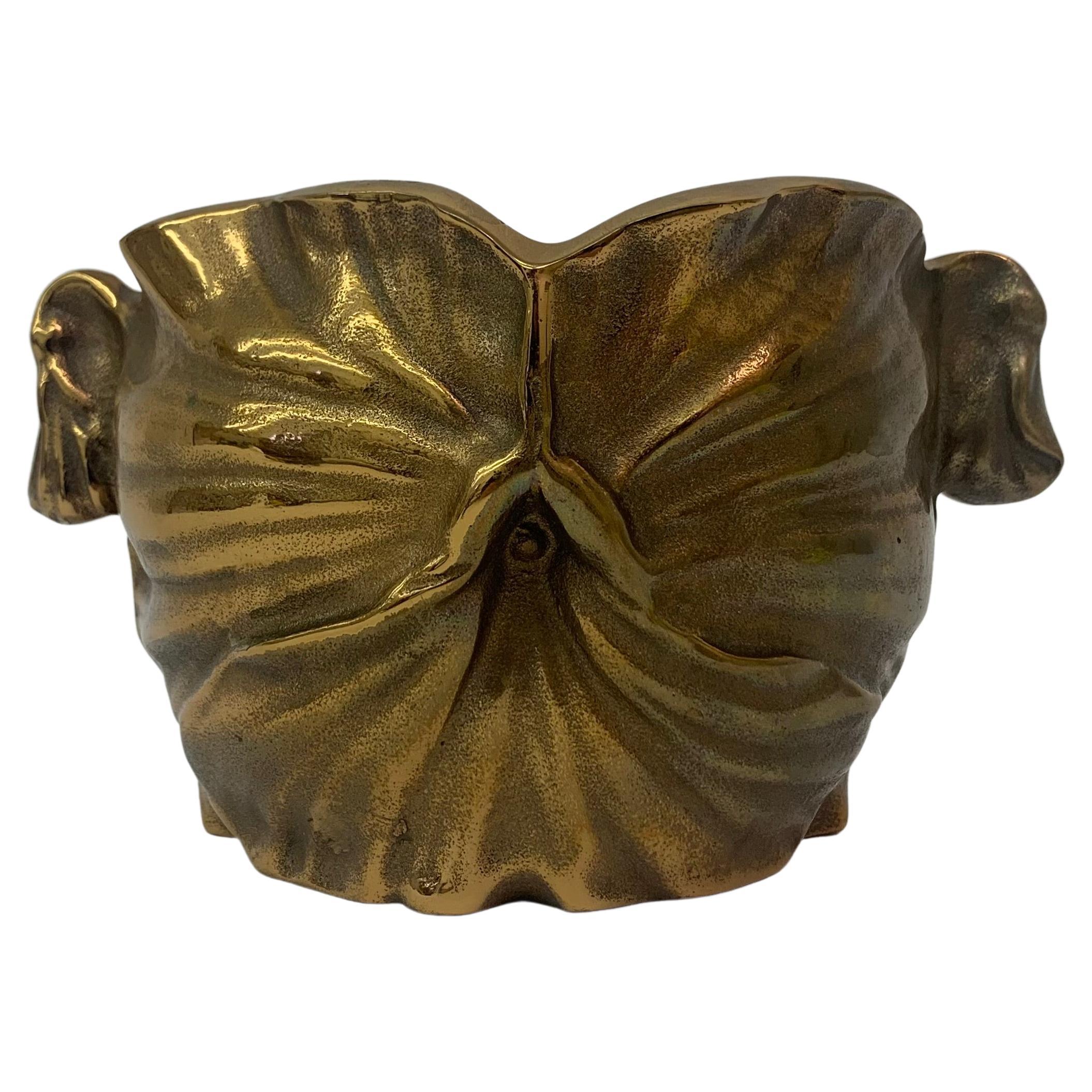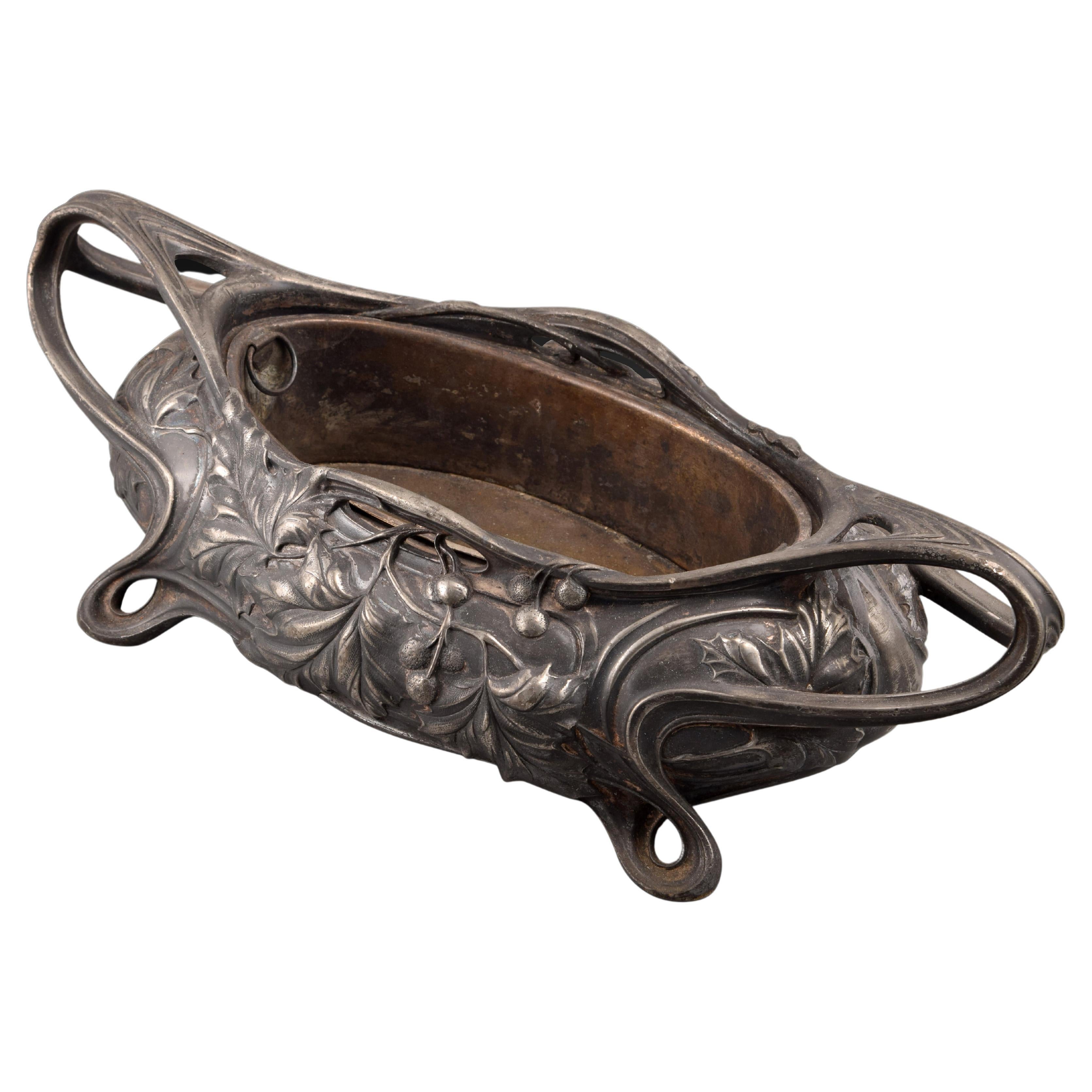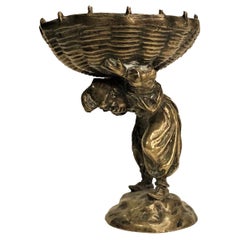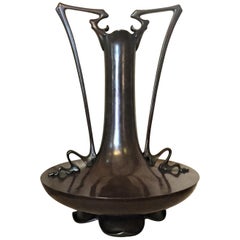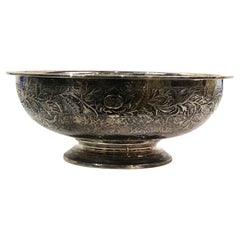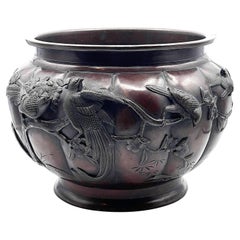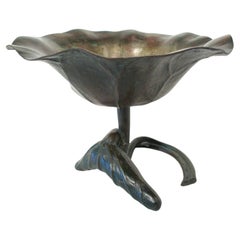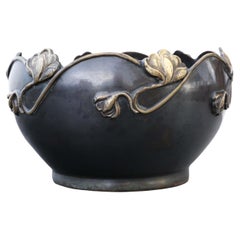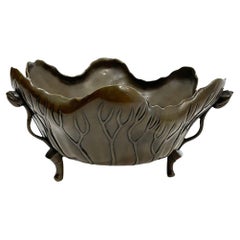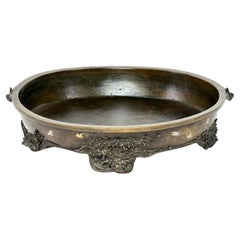Items Similar to Japanese Meiji Era Bronze Lotus Leaf Bowl, Vide Poche, ca. 1900
Want more images or videos?
Request additional images or videos from the seller
1 of 8
Japanese Meiji Era Bronze Lotus Leaf Bowl, Vide Poche, ca. 1900
$1,800
£1,359.55
€1,571.25
CA$2,524.78
A$2,808.20
CHF 1,469.75
MX$34,250.76
NOK 18,467.96
SEK 17,371.50
DKK 11,727.82
About the Item
DIMENSIONS: Height: 4 inches Width: 6 inches Depth: 6 inches
ABOUT THE OBJECT
With the laconic Japanese-style Art Nouveau design, filled with symbolism and metaphorism, this multi-use bowl (perfect as vide poche) is made of dark brown-patinated bronze, and represents a lotus flower slightly rising above the level of the table on a coiled stem. At the bottom of the stem an unripe cocoon of a silkworm butterfly nestled comfortably. A small graceful frog adorns the top of the flower.
ABOUT MEIJI PERIOD
The Meiji period (????, Meiji-jidai), also known as the Meiji Era, is a; Japanese era which extended from September 8, 1868 through July 30, 1912.
- Dimensions:Height: 4 in (10.16 cm)Width: 6 in (15.24 cm)Depth: 7 in (17.78 cm)
- Style:Art Nouveau (Of the Period)
- Materials and Techniques:Bronze,Patinated
- Place of Origin:
- Period:1900-1909
- Date of Manufacture:circa 1900
- Condition:Wear consistent with age and use. We make our best effort to provide a fair and descriptive condition report. Please examine photos attentively, as they are an integral part of the description. Send us a message to request more details or discuss price.
- Seller Location:New York, NY
- Reference Number:1stDibs: LU2819330231572
About the Seller
5.0
Gold Seller
Premium sellers maintaining a 4.3+ rating and 24-hour response times
Established in 1993
1stDibs seller since 2017
84 sales on 1stDibs
Typical response time: 8 hours
- ShippingRetrieving quote...Shipping from: New York, NY
- Return Policy
Authenticity Guarantee
In the unlikely event there’s an issue with an item’s authenticity, contact us within 1 year for a full refund. DetailsMoney-Back Guarantee
If your item is not as described, is damaged in transit, or does not arrive, contact us within 7 days for a full refund. Details24-Hour Cancellation
You have a 24-hour grace period in which to reconsider your purchase, with no questions asked.Vetted Professional Sellers
Our world-class sellers must adhere to strict standards for service and quality, maintaining the integrity of our listings.Price-Match Guarantee
If you find that a seller listed the same item for a lower price elsewhere, we’ll match it.Trusted Global Delivery
Our best-in-class carrier network provides specialized shipping options worldwide, including custom delivery.More From This Seller
View AllArt Nouveau Sculptural Gilded Vienna Bronze Candy Bowl, ca. 1900
Located in New York, NY
Probably, Austrian, this very original Art Nouveau orientalist sculptural candy bowl made of gilded Viennese bronze, depicts a young street vendor in bloomers and a fez, holding a hu...
Category
Antique Early 1900s Austrian Art Nouveau Decorative Bowls
Materials
Bronze
Japanese Art Nouveau Meiji Period Patinated Bronze Vase, circa 1900
Located in New York, NY
Although unmarked, this rare and important, grand but at the same exquisite patinated bronze vase has just a very few little details, defying the shape of the handles, as well as the...
Category
Antique Early 1900s Japanese Art Nouveau Vases
Materials
Bronze
Black, Starr & Frost, American Art Nouveau Sterling Silver Bowl, ca. 1900
By Black, Starr & Frost
Located in New York, NY
American Art Nouveau
Black, Starr & Frost
Serving Bowl
Sterling Silver
Circa 1900
DIMENSIONS
Height: 3.75 inches
Diameter: 9.75 inches
Weight: 21.13 ozt
ABOUT MAKER ~ Black, Star...
Category
Antique Early 1900s American Art Nouveau Serving Bowls
Materials
Silver
Japanese Edo Period Bronze Jardinière w/ Birds & Cherry Blossom Tree, 19th C.
Located in New York, NY
#350
Japanese Edo Period Bronze Jardinière w/ Birds & Cherry Blossom Tree, 19th C.
DIMENSIONS:
Height: 9 inches
Diameter: 12 inches
DETAILS
Edo Period (1603-1868) Meiji Period (...
Category
Antique Mid-19th Century Japanese Japonisme Planters, Cachepots and Jard...
Materials
Bronze
French Art Nouveau Patinated Bronze Sculptural Iris Vase, ca. 1900
Located in New York, NY
ABOUT IRIS
The iris is a special and mysterious flower. Not only because of its striking appearance, but also from an artistic and historical point of view. It is also like a work of art, as though created by Mother Nature. The unique leaves of this plant not only create wonderful shadow casts, but also look as if they were painted by hand. It's no wonder that iris acts as the muse for countless artists, and can be seen in many famous works of art.
The iris was first spotted in the time of Pharaoh Thutmose, in 1504 BC. He had the iris inscribed into the wall reliefs of a temple as a sign of his power, as well as decorating his sceptre with motifs of the flower. Since then, the iris has been a symbol of victory in Egypt. But the symbolism of the iris goes further than that. In Japan, the flower represents courage and is the symbol of the boys' festival. In Islamic cultures, the iris is a symbol of prosperity. In Europe, the flower was a popular weapon symbol in the Middle Ages and stood for chivalry. And in Christianity, the iris was seen as a symbol of the trinity because of its three-part flowers. With more than 300 varieties, the iris is now the most popular flower among growers and gardeners following the rose.
Countless artists use the iris in their works and the flower is present in all eras. You can see the flower on furniture, vases, jewelry, fabrics, sculptures, coats of arms and much more. Did you know that the iris is also called the sword lily? It's not a coincidence that it used to symbolize physical and emotional pain and suffering caused by a weapon. We also see the flower in religious art, where it's often associated with Mary and Jesus. The iris is also associated with the Greek goddess Iris, where the flower symbolizes reconciliation and divine messages. This is also reflected in many paintings.
Finally, the iris is also visible in Dutch and Flemish still-life paintings. This can be in a religious form, incorporated into an object or as a decorative flower.
In the Art Nouveau art movement, the iris (along with other plants, such as the birch) was often used as an expression of feminine beauty. With its almost otherworldly appearance, the iris is perfectly suited to the Art Nouveau aesthetic and is featured in many well-known works of art. The poet of that era, Hermann Hesse...
Category
Antique Early 1900s French Art Nouveau Planters, Cachepots and Jardinières
Materials
Bronze
Japanese Meiji Period Carved Root Wood Serving Tray, ca. 1868-1912
Located in New York, NY
DIMENSIONS
Height: 9.25 inches
Width: 11.5 inches
Depth: 10.5 inches
ABOUT MEIJI PERIOD
The Meiji Era was the 44-year period of Japan's history from 1868 to 1912 when the country was under the rule of the great Emperor Mutsuhito. Also called the Meiji Emperor, he was the first ruler of Japan to wield actual political power in centuries.
It was during the Meiji period that Japanese art students first went to Europe to study Western painting, and developed a new style of painting based on these techniques, known as yoga (or ‘Western style’).
Yoga painting...
Category
Antique Late 19th Century Japanese Other Lacquer
Materials
Wood
You May Also Like
John Scott Bradstreet - Bronze Lotus Bowl - United States - circa 1900
By John Scott Bradstreet
Located in Chatham, ON
JOHN SCOTT BRADSTREET (Attributed) - Arts & Crafts cast and patinated bronze center-piece flower bowl taking the form of a lotus - later patinated flower 'frog' - unsigned - United S...
Category
Early 20th Century American Arts and Crafts Decorative Bowls
Materials
Bronze
$2,450 Sale Price
30% Off
Antique Large Quality Art Nouveau Jardinière Bowl Censor Planter Japanese
Located in Wisbech, Cambridgeshire
Antique large quality Art Nouveau Jardinière bowl censor planter Japanese Oriental mixed metal Meiji Period early 20th Century.
Would look amazing in the right location and make a...
Category
Early 20th Century Planters, Cachepots and Jardinières
Materials
Metal
$766 Sale Price
30% Off
Japanese Bronze Ikebana Lotus Footed Bowl
Located in Delft, NL
Japanese bronze Ikebana Lotus footed bowl
A Japanese Meiji Period (1868-1912) footed bowl in the shape of a leaf with Lotus flowers raided o...
Category
Antique Late 19th Century Japanese Antiquities
Materials
Bronze
Japanese Meiji Period Bronze Suiban Ikebana Planter Bowl with Inlay
Located in San Francisco, CA
This large fine quality bronze bowl planter, known as a Suiban Ikebana, dates to the Meiji period (late 19th to early 20th century) and is perfect for flower arrangements or bonsai a...
Category
Antique Late 19th Century Japanese Meiji Metalwork
Materials
Gold, Silver, Bronze
Art Nouveau Bronze Flower Pot, 1930s
Located in Delft, NL
Art Nouveau bronze flower pot, 1930s.
Category
Vintage 1930s French Art Nouveau Planters, Cachepots and Jardinières
Materials
Bronze
Art Nouveau Centerpiece or Planter. Metal. Víctor Saglier, Late 19th Century
By Victor Saglier
Located in Madrid, ES
Table center or planter. Tin, metal. Víctor Saglier, towards the end of the 19th century.
With marks on the base.
Oval centerpiece with interior tray with handles, decorated on t...
Category
Antique Late 19th Century French Art Nouveau Decorative Bowls
Materials
Metal
More Ways To Browse
Japan 1900
Lotus Vase
1900 Japanese Vase
Meiji Bronze Vase
Butterfly Bowl
Japanese Meiji Bronze Vessel
Circa 1900 Japanese Vase
Japanese Bronze Flower Vase
4 Frogs
Frog Vase
Japanese Patinated Bronze Vase
Antique Frog Vases
Japanese Art Nouveau Bronze
Japanese Bronze Bowl
Frog Table
Flower Frog Vase
Flower Vase With Frog
Japanese Bronze Lotus
